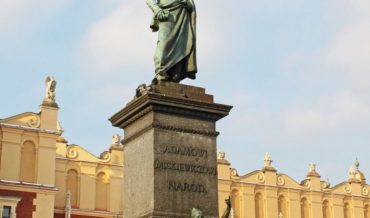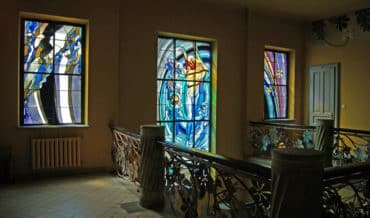Contents
Key Facts
• Polish sculptor born in 1854 in Baranów Sandomierski, died in 1922 in Krakow
• Graduated from the Academy of Fine Arts in Krakow in 1878
• Collaborated with Stanisław Wyspiański and studied in Vienna during the Secession movement
• Professor of sculpture at the Academy of Fine Arts from 1897-1922
• Created iconic monuments including Grażyna and Litawór in Planty Park and theatrical allegories
• Commemorated with Dauna Street in Krakow's Wola Duchacka district
Early Life and Artistic Formation
Alfred Daun emerged as one of Poland's most significant sculptors during the critical period of national cultural revival in the late 19th century. Born in 1854 in Baranów Sandomierski (in historical Małopolska), Daun's artistic journey began in a region where Polish cultural identity was preserved through artistic expression despite political partition.
His formal education at the Academy of Fine Arts in Krakow proved transformative. Graduating in 1878, Daun completed his studies during the academy's golden period under the directorship of Władysław Łuszczkiewicz, when the institution served as a beacon for Polish artistic renaissance. This education grounded him in classical sculptural techniques while exposing him to the emerging currents of Polish Romanticism in visual arts.
Professional Development and European Influences
The Wyspiański Workshop Experience
Daun's collaboration with Stanisław Wyspiański's workshop represented a pivotal chapter in Polish art history. Wyspiański, the polymath genius of the Young Poland movement (Młoda Polska), introduced Daun to revolutionary approaches that synthesized traditional Polish themes with Art Nouveau aesthetics. This partnership exposed Daun to integrated artistic creation, where sculpture complemented stained glass, theatrical design, and architectural decoration.
Working under Wyspiański's guidance, Daun developed his distinctive ability to translate literary narratives into three-dimensional form, a skill that would define his most celebrated works. The workshop environment fostered his understanding of how sculpture could serve both artistic and patriotic purposes in occupied Poland.
Vienna and the Secession Influence
Daun's Vienna period coincided with the height of the Austrian Secession movement, led by artists like Gustav Klimt and Otto Wagner. This exposure to cutting-edge European modernism profoundly influenced his sculptural philosophy. In Vienna, he studied monumental sculpture techniques and observed how public art could reshape urban environments.
The imperial capital's rich museum collections and active artistic community provided Daun with international perspectives on sculptural traditions, from classical antiquity to contemporary innovations. This cosmopolitan education enhanced his technical mastery while reinforcing his commitment to Polish cultural themes.
Academic Legacy and Pedagogical Innovation
Transforming Sculpture Education (1897-1922)
As Professor of Sculpture at the Academy of Fine Arts beginning in 1897, Daun revolutionized Polish sculptural education. His 25-year teaching career shaped an entire generation of Polish artists who would dominate the field through the interwar period. His pedagogical approach balanced rigorous technical training with creative interpretation of Polish historical and literary subjects.
Daun's teaching methodology emphasized practical monument creation alongside studio work. Students learned not only sculptural techniques but also the complex processes of public commission execution, from initial concept through bronze casting and installation. This comprehensive approach produced sculptors capable of addressing Poland's post-independence need for national monuments.
Industrial Arts Integration
His later role as instructor of drawing and modeling at Krakow's School of Industry demonstrated Daun's progressive vision of art education. He recognized that applied arts training was essential for Poland's economic development and cultural distinctiveness. His industrial school curriculum integrated fine arts principles with practical design applications, contributing to the emergence of distinctly Polish industrial aesthetics.
Masterworks and Cultural Impact
Grażyna and Litawór: Literary Sculpture in Planty Park
Daun's sculpture of Grażyna and Litawór in Planty Park represents his masterpiece of literary interpretation in bronze. These figures, drawn from Adam Mickiewicz's narrative poems, embody the heroic ideals of Polish Romanticism. The sculpture demonstrates Daun's mastery of dynamic composition and his ability to capture both physical beauty and spiritual nobility.
Located in Europe's most extensive urban park belt, the sculpture has become an iconic symbol of Krakow's cultural identity. The work showcases Daun's innovative approach to narrative sculpture, where multiple figures interact to suggest both dramatic tension and romantic devotion. The technical execution reveals his Vienna-influenced understanding of surface treatment and atmospheric effects.
Jordan Park Portrait Gallery
For Henryk Jordan Park, Europe's pioneering public recreation space, Daun created an distinguished series of portrait busts featuring prominent Polish cultural figures. These works served the park's educational mission while demonstrating Daun's exceptional skill in psychological portraiture. Each bust captures not merely physical likeness but the intellectual character and historical significance of its subject.
The portrait series reflects Daun's mature artistic philosophy, where technical precision served patriotic purpose. These busts introduced park visitors to Polish intellectual heritage while maintaining the highest standards of sculptural artistry.
Słowacki Theatre Allegorical Program
Daun's allegorical sculptures for the Juliusz Słowacki Theatre – representing Music, Opera, and Operetta – showcase his versatility in symbolic and decorative sculpture. These works demonstrate his sophisticated understanding of architectural sculpture, where artistic elements enhance rather than compete with building design.
The theatrical allegories reflect Daun's deep engagement with performing arts culture, likely influenced by his Wyspiański collaboration. Each figure embodies specific artistic qualities while contributing to a unified decorative program that elevates the theatre's cultural significance.
The Lost Monument: Lilia Weneda
Among Daun's documented works was the Monument of Lilia Weneda, inspired by Juliusz Słowacki's romantic drama. This sculpture, which appears to have been destroyed or lost during the 20th century's upheavals, represented Daun's engagement with Romantic literary themes. The work exemplified his ability to transform dramatic literature into sculptural narrative.
Historical Context and Artistic Significance
Cultural Nationalism Through Art
Daun's career coincided with the Polish cultural revival movement that maintained national identity during political partition. His sculptures served as vehicles for Polish cultural memory, preserving heroic narratives and celebrating intellectual achievements when direct political expression was impossible.
Working within the Austrian partition's relative cultural freedom, Daun and his contemporaries created an artistic renaissance that prepared the ground for Poland's eventual political independence in 1918. His public sculptures functioned as unofficial national monuments, fostering patriotic consciousness through aesthetic experience.
Stylistic Evolution and Innovation
Daun's artistic development reflects the broader evolution of European sculpture from academic tradition to modern expression. His early works demonstrate mastery of classical techniques, while later pieces incorporate Secession-influenced stylistic innovations and psychological insight. This evolution positioned him as a bridge figure between 19th-century academic sculpture and emerging modernist approaches.
Enduring Legacy and Recognition
Urban Commemoration
The naming of Dauna Street in Wola Duchacka acknowledges Alfred Daun's lasting contribution to Krakow's cultural landscape. This honor places him among the city's most significant cultural figures, ensuring his memory endures in the urban geography he helped beautify. His inclusion among famous Polish people reflects his lasting impact on the nation's artistic heritage.
Contemporary Relevance
Daun's sculptures continue to serve their original cultural and educational functions while gaining appreciation as important examples of Polish Art Nouveau sculpture. His works in Planty Park and other public spaces remain popular destinations for both residents and tourists, testament to their enduring artistic appeal.
His integration of Polish literary themes with international sculptural techniques created works that speak simultaneously to local cultural identity and universal aesthetic values. This synthesis represents one of the most successful achievements of the Young Poland movement's cultural project.
Alfred Daun died in 1922 in Krakow, witnessing the restoration of Polish independence and the beginning of the Second Republic. His death marked the end of an era in Polish sculpture, but his works continue to enrich Krakow's cultural landscape alongside the city's other historic treasures like Wawel Castle. Today, his sculptures serve as tangible links to the period when art and patriotism united to preserve Polish cultural identity through the darkest chapters of national history.
His artistic legacy demonstrates how individual creativity, when combined with deep cultural commitment and technical mastery, can produce works that transcend their historical moment to achieve lasting cultural significance. In the streets, parks, and theaters of modern Krakow, Alfred Daun's vision continues to inspire new generations of artists and art lovers.

